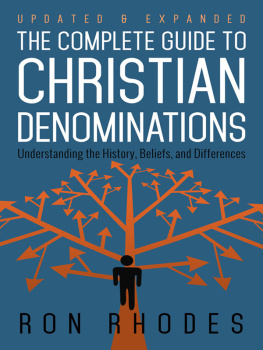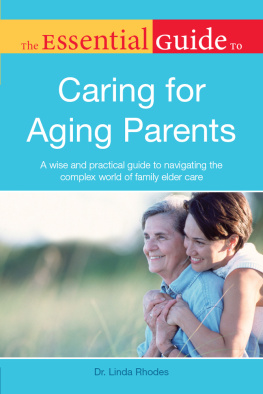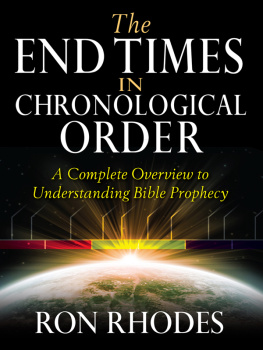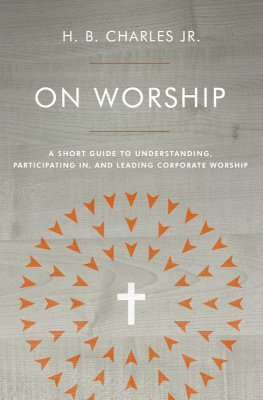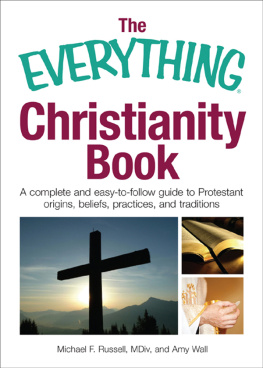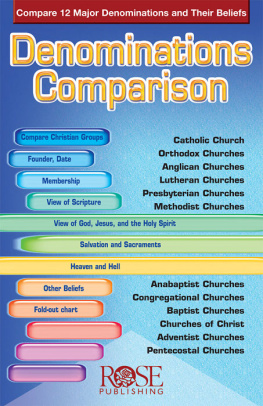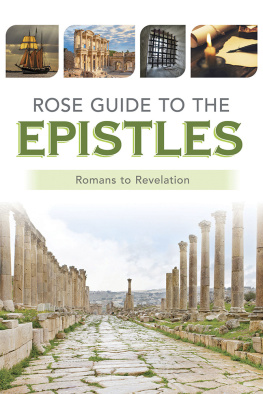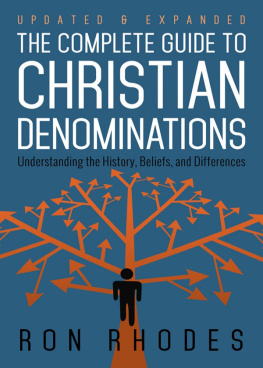

HARVEST HOUSE PUBLISHERS
EUGENE, OREGON
Unless otherwise indicated, all Scripture quotations are taken from the HOLY BIBLE, NEW INTERNATIONAL VERSION, NIV. Copyright 1973, 1978, 1984 by the International Bible Society. Used by permission of Zondervan. All rights reserved.
Verses marked NKJV are taken from the New King James Version. Copyright 1982 by Thomas Nelson, Inc. Used by permission. All rights reserved.
Verses marked NASB are taken from the New American Standard Bible, 1960, 1962, 1963, 1968, 1971, 1972, 1973, 1975, 1977, 1995 by The Lockman Foundation. Used by permission. (www.Lockman.org)
All italicized emphasis in Scripture quotations is added by the author.
Cover by Dugan Design Group, Minneapolis, Minnesota
Cover illustration @ Michael Brown / Fotolia
THE COMPLETE GUIDE TO CHRISTIAN DENOMINATIONS
Copyright 2005/2015 Ron Rhodes
Published by Harvest House Publishers
Eugene, Oregon 97402
www.harvesthousepublishers.com
ISBN 978-0-7369-5291-0 (pbk.)
ISBN 978-0-7369-5292-7 (eBook)
The Library of Congress has cataloged the edition as follows:
Rhodes, Ron.
The complete guide to Christian denominations / Ron Rhodes.
p. cm.
Includes bibliographical references and index.
ISBN 0-7369-1289-4 (pbk.)
1. Protestant churchesUnited States. 2. Protestant churchesDoctrines. I. Title.
BR516.5.R47 2005
280.4dc22
2004017507
All rights reserved. No part of this electronic publication may be reproduced, stored in a retrieval system, distributed, or transmitted in any form or by any meanselectronic, mechanical, digital, photocopy, recording, or any otherwithout the prior written permission of the publisher. The authorized purchaser has been granted a nontransferable, nonexclusive, and noncommercial right to access and view this electronic publication, and purchaser agrees to do so only in accordance with the terms of use under which it was purchased or transmitted. Participation in or encouragement of piracy of copyrighted materials in violation of authors and publishers rights is strictly prohibited.
In honor of the head of the church (Ephesians 5:23), who purchased the church with His own blood (Acts 20:28)
Jesus Christ
Researching every denomination in this book required considerable effort. Representatives of many of these denominations made the task easier by pointing me to helpful information regarding their groups. To these individualstoo many to listI offer a heartfelt thanks.
Kerri, David, and Kylie (my wife and adult children)as always, I could not have written this book without your continued support. God has used you mightily in my life!
CONTENTS

T he word Christian is used only three times in the New Testament, most importantly in Acts 11:26 (see also Acts 26:28 and 1 Peter 4:16). In Acts 11:26, we are told simply and straightforwardly, The disciples were called Christians first at Antioch. This would have happened around AD 42, about a decade after Christ died on the cross and rose from the dead.
Until this time, the followers of Jesus referred to themselves as brothers (Acts 15:1,23), disciples (Acts 9:26), believers (Acts 5:12), and saints (Romans 8:27). Now, in Antioch, they were called Christians.
The term is loaded with significance. Among the ancients, the ian (or ean ) ending meant belonging to the party of. Herodians belonged to the party of Herod. Caesareans belonged to the party of Caesar. Christians belonged to Christ. And Christians were loyal to Christ, just as the Herodians were loyal to Herod and Caesareans were loyal to Caesar (see Mark 3:6; 12:13).
The name Christian is noteworthy because these followers of Jesus were recognized as members of a separate group. They were distinct from Judaism and from all other religions of the ancient world. We might loosely translate the term Christian, those belonging to Christ, Christ-ones, or perhaps Christ-people. They are ones who follow the Christ.
Those who have studied the culture of Antioch have noted that the Antiochians were well-known for making fun of people. They may have used the word Christian as a term of derision, an appellation of ridicule. Nevertheless, history reveals that by the second century, Christians adopted the title as a badge of honor. They took pride (in a healthy way) in following Jesus. They had a genuine relationship with the living, resurrected Christ, and they were utterly faithful to Him, even in the face of death.
The city of Antioch was a mixture of Jews and Gentiles. People of both backgrounds in this city became followers of Jesus. What brought these believers unity was not their race, culture, or language. Rather, their unity was rooted in the personal relationship each of them had with Jesus. Christianity crosses all cultural and ethnic boundaries.
If a Christian is one who has a personal relationship with Jesus Christ, then Christianity is a movement of people who have personal relationships with Jesus Christ. This may sound simplistic, but from a biblical perspective, this is the proper starting point.
In the New Testament, the early Christians never referred to their collective movement as Christianity, even though they used the term Christian with greater frequency as the movement grew in numbers. By the time of Augustine (AD 354430), the term Christianity appears to have become a widespread appellation for the Christian movement.
The Birth of the Church
Scripture refers to both the universal church and the local church. The universal church is a company of people who have one Lord and who share together in one gift of salvation in the Lord Jesus Christ (Titus 1:4; Jude 3). It may be defined as the ever enlarging body of born-again believers who comprise the universal body of Christ, over which He reigns as Lord.
Although the members of the churchand members of different denominationsmay differ in age, sex, race, wealth, social status, and ability, true believers are all joined together as one people (Galatians 3:28). All of them share in one Spirit and worship one Lord (Ephesians 4:3-6). This body is comprised only of believers in Christ. The way one becomes a member of this universal body is to simply place faith in Christ. If youre a believer, youre in!
The word church is translated from the Greek word ekklesia . This Greek word comes from two smaller words. The first is ek , which means out from among. The second is klesia , which means to call. Combining the two words, ekklesia means to call out from among. The church represents those whom God has called out from among the world and from all walks of life. All are welcome in Christs church.
Many theologians believe the church did not exist in Old Testament times (I think they are right). Matthew 16:18 cites Jesus as saying, I will build my church (future tense). This indicates that when He spoke these words, the church did not yet exist. This is consistent with the Old Testament, which includes no reference to the church. In the New Testament, the church is portrayed as distinct from Israel in such passages as Romans 9:6, 1 Corinthians 10:32, and Hebrews 12:22-24. Therefore, we should not equate the church with believing Israelites in Old Testament times.
Scripture indicates that the universal church was born on the Day of Pentecost (see Acts 2; compare with 1:5; 11:15; 1 Corinthians 12:13). We are told in Ephesians 1:19-20 that the church is built on the foundation of Christs resurrection, meaning that the church could not have existed in Old Testament times. The church is thus called a new man in Ephesians 2:15.
Next page
